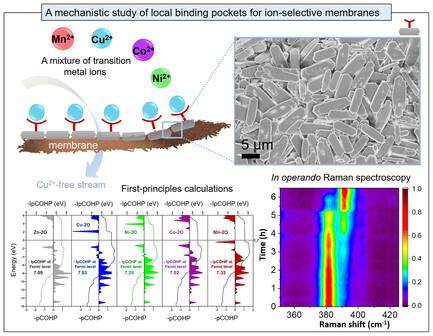An Adsorptive Membrane Platform for Precision Ion Separation: Membrane Design and First‐Principles Studies
引用次数: 0
Abstract
One of the key challenges in separation science is the lack ofprecise ion separation methods and mechanistic understanding crucial for efficiently recovering critical materials from complex aqueous matrices. Herein, first‐principles electronic structure calculations and in‐situ Raman spectroscopy are studied to elucidate the factors governing ion discrimination in an adsorptive membrane specifically designed for transition metal ion separation. Density functional theory calculations and in‐situ Raman data jointly reveal the thermodynamically favorable binding preferences and detailed adsorption mechanisms for competing ions. How membrane binding preferences correlate with the electronic properties of ligands is explored, such as orbital hybridization and electron localization. The findings underscore the importance of the phenolate group in oxime ligands for achieving high selectivity among competing transition metal ions. In‐depth understanding on which specific atomistic site within the microenvironment of metal‐ligand binding pockets governs the ion discrimination behaviors of the host will build a solid foundation to guide the rational design of next‐generation materials for precision separation essential for energy technologies and environment remediation. In tandem, synthetic controllability is demonstrated to transform 3D micrometer‐scale crystals to a 2D crystalline selective layer in membranes, paving the way for more precise and sustainable advances in separation science.

用于精确离子分离的吸附膜平台:膜设计和第一原理研究
分离科学面临的主要挑战之一是缺乏精确的离子分离方法以及对从复杂水基中有效回收关键材料的机理认识。本文研究了第一原理电子结构计算和原位拉曼光谱,以阐明专为分离过渡金属离子而设计的吸附膜中的离子分辨因素。密度泛函理论计算和原位拉曼数据共同揭示了竞争离子在热力学上有利的结合偏好和详细的吸附机制。研究还探讨了膜结合偏好如何与配体的电子特性相关联,如轨道杂化和电子定位。研究结果强调了肟配体中的苯酚基对于在竞争性过渡金属离子中实现高选择性的重要性。深入了解金属-配体结合袋微环境中哪个特定原子位点控制着宿主的离子鉴别行为,将为指导下一代材料的合理设计奠定坚实的基础,从而实现能源技术和环境修复所必需的精确分离。同时,研究还展示了将三维微米级晶体转化为膜中二维晶体选择层的合成可控性,为分离科学更精确、更可持续的进步铺平了道路。
本文章由计算机程序翻译,如有差异,请以英文原文为准。
求助全文
约1分钟内获得全文
求助全文
文献相关原料
| 公司名称 | 产品信息 | 采购帮参考价格 |
|---|

 求助内容:
求助内容: 应助结果提醒方式:
应助结果提醒方式:


